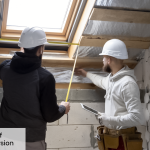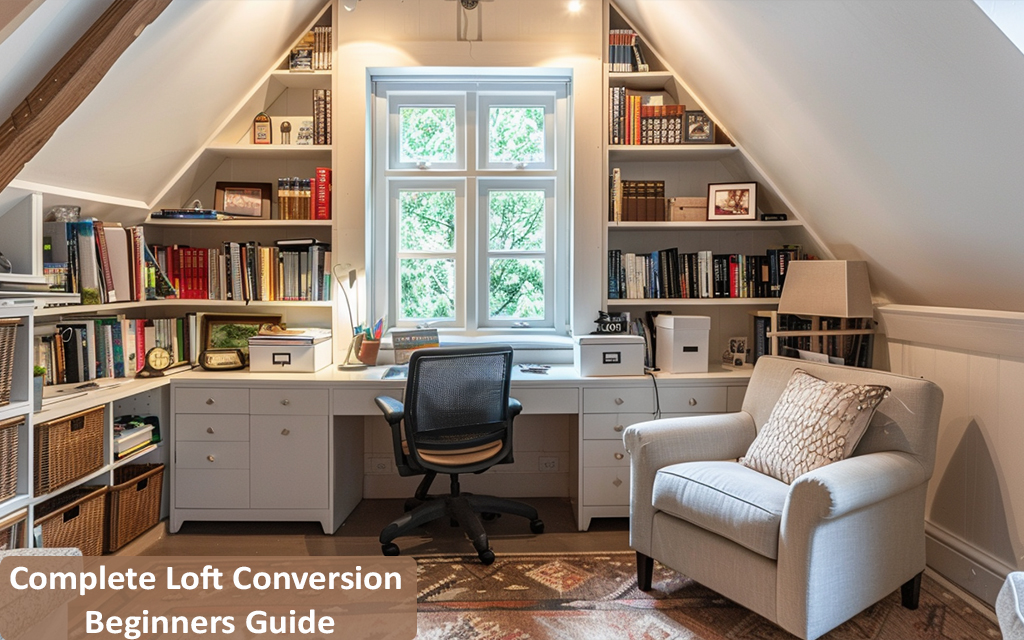Loft Conversion Complete Beginners Guide
Getting Started
Everyone needs more space. Whether it’s about growing family needs, teenagers returning from university, elder parents joining in or whatever the reason, space is the biggest need of every homeowner. Loft conversion is the ultimate solution that enables you to expand your home upwards. The unused attic space can be turned into amazing living spaces with loft conversion in England. It’s the most economical method than moving to a bigger house or when you don’t want to extend your home sideways or rear. TEL Constructions, the leading loft conversion company in London, brings to you this exclusive loft conversion guide that’ll walk you through all the things that come to your mind. So, let’s get started.
What is Loft Conversion
Loft Conversion is a process where new habitable space is created by transforming the existing space at the top of the house usually known as an attic. This space is typically underdeveloped, either it is empty or houses extra things from the home. If your attic space or loft is large enough, the process could be simple just as doing the flooring, wall, painting and installing new windows. Loft conversions are usually popular in places where there aren’t external spaces to extend or where getting planning permission for an extension is a tough task. According to industry experts and surveyors, a loft conversion with a bedroom and ensuite would increase the value of the property by more than 20%.
Is Loft Conversion Suitable For My Property?
The basic criteria for loft conversion are that your home should have sufficient space and a pitched roof. However, there may be certain loft spaces that are not suitable for conversion. Complicated or tricky spaces can be difficult to construct and can be costly as well. So, you must ensure that the final living space you’re getting after loft conversion is fully functional, useful and offers you a good return on investment (ROI). Here are certain factors that’ll help you understand whether your property is suitable for loft conversions or not.
- Available Headspace or Headroom: You need to make sure that your loft has a minimum head height of either 2.2 m or 2.4 m for a traditional roof. This headroom is measured from the joists of the floor of the attic to the underside of the ridge beam. For a modern trussed roof, the minimum height should be 2.4 m to 2.6 m.
- Loft Space: Is there sufficient loft space that’ll give you a good room with standard dimensions? If not, you may reach out to a loft conversion company near you for a more practical solution.
- Pitch Of The Roof: The more steeper the roof will be, it will be easier to get it loft converted. Generally, the angles above 30 degrees work perfectly as you’ll get more head height.
- Boilers, Chimneys, or Water Tanks in Loft: For every loft conversion, you need empty attic space. If you have chimneys, boilers or even water tanks placed in the loft, remove them, and shift them to a new place.
- Felt: Your roof should be felted, or it should be weather-resistant. It’s easy to identify as you’ll easily see the roof tiles and the battens if you don’t have felt placed. But, if you’re able to see a black bituminous paper, this means you have felt placed beneath your roof.
- Headspace For Staircase: Even if you have sufficient headroom in the loft, you need to ensure that your loft stairs also meet the height recommended in the building regulations. The minimum height should be 1.9m from the centre of the flight and for the edges (having sloping roofs) the height should be 1.8m.
- Roof Type: Depending on the roof type whether a trussed roof or cut roof, different approaches will be used for making loft conversion. A cut roof or traditional roof was popular in homes built before the 1960s and had purlins, joists, and rafters. The majority of the space is left free. For a trussed roof, the support is given by W-shaped trusses providing a cross-sectional view.
You may be required to work with a loft conversion contractor to ensure that your property has solid foundations to take the load of the new property.
Types of Loft Conversion
There are multiple types of loft conversion available. It depends on the type of roof, your budget and for what purpose you want to use that loft. Here is a list of the most popular loft conversion types in the UK market. However, your construction contractor, builder or loft conversion company will be able to guide you to the best option for your property.
- Dormer Loft Conversion: Dormer loft conversion is the most popular type of loft conversion that offers ample space to construct an extra bedroom with or without an ensuite. Dormers, which are box-shaped structures, are added to the rear of the pitched roof. This loft conversion when done on the rear comes under permitted development while adding a dormer to the front or side may require you to apply for planning permissions. Based on your requirements you may choose amongst these types of dormer loft conversion.
- Single Dormer: Single Dormer or small dormer loft conversion allows to add dormer or dormer windows only to the required area of the roof.
- Full Width Dormer: Here the dormer spans across almost the entire pitched slope and offers maximum space.
- Side Dormer: Here the dormer is added on the side of a hipped roof. Here the access to the loft is through under the hip.
- L-shaped Dormer: Here a L-shaped dormer is added to two roofs that are joined together. These are mainly popular in Victorian properties.
- Hip to Gable Loft Conversion: One or more hips of the hipped roof are extended and replaced by Gable walls. Extra space is created by extending through the ridge line and adding a triangular wall (Gable) above the supporting walls of the home.
- Mansard Loft Conversion: A mansard loft conversion is the most expensive of all as it requires major roof rebuilding activities. It’s more like adding a new storey to the existing home. This loft conversion is ideal for terraced houses and period properties. Here the sloped roof is turned into a vertical wall with an angle of 72 degrees. Now the roof is flat, and the skylights are added to the new roof structure. Mansard conversion is mainly done to the rear of the property, while conversion can be done in front and side by seeking planning permissions.
- Roof Light or Skylight or Velux Loft Conversion: This is one of the most affordable, economical, and budget-friendly solutions to add new space to your home. Here windows are added to the roof to illuminate the interiors of the loft. These windows are also known as Velux windows or roof lights or skylights. If these windows are overlooking your neighbours’ property, then you may need to use obscured glass as per the building regulations to keep privacy intact. You will be requiring adding the loft stairs, reinforce the flooring and perform the plumbing, electric, insulation etc works.
Benefits of Loft Conversion
Loft conversion comes with countless benefits, they not only add to living space but also add value to the property as well. Thereby, making it one of the most beneficial investments you make for your home. Have a look at some of the most prominent ones.
- Multi-use space: The new space can be used for multiple uses such as an office room, playroom, bedroom with ensuite, gym, cinema room etc.
- Energy-Efficient home: The lofts have skylights that naturally illuminate the home with natural light. Apart from this, insulated roofs ensure that the loft stays cozy the entire day.
- Adds Value to Home: Getting a loft conversion will boost the value of your home by more than 20% and turn it into one of the best choices for potential buyers.
- Better than moving: Getting your loft converted to a liveable space is much more affordable and cheaper than moving to a new home just for the sake of space. While moving to a new home there are many other additional fees that you need to pay such as solicitor fees, stamp duty, surveying and much more.
- Room with a view: The beautiful skylight windows enable you to stargaze on beautiful clear evenings. These windows are located at a higher level than normal windows in your home which allow you to get a spectacular view of the surroundings.
- Rarely require planning permissions: Most of the loft conversions fall under permitted developments and do not require planning permissions.
- Quick and effortless process: Loft conversion is an easy and quick process that transforms your home with minimum disruption to your everyday routine.
What All Spaces Can Be Created By Undergoing Loft Conversion
The space created by undergoing loft conversions can be used in a various way, such as:
- Home Office: Convert the loft space into an office space by placing formal furniture to match the aesthetics.
- Gym: Get a bespoke gym or a workout by crafting an amazing healthy zone in your loft.
- Entertainment area: Give wings to your imagination by converting your newly constructed loft into a home cinema.
- Dressing room: Do not have space downstairs to dress up and you often feel uncomfortable while getting ready for your office or any occasion?
- Small Bedroom: Feeling the need for a guest room or kids’ room, a dormer loft conversion is perfect for that need.
- Master bedroom with ensuite: Make your home look more grand by adding a master bedroom with an attached ensuite.
- Creative Studio: Go creative and pursue your hobbies in an exclusive space crafted by undergoing a loft conversion.
Loft Conversion Stairs
While loft stairs aren’t the first thing that comes to mind, they do play a key role in making the loft accessible. It’s worth considering how much amount of space a staircase would take, what design would go best and other things. Even if you’re going for a space-saving staircase, it will probably take a sizeable chunk of that room. Make sure to consider the flow of your room as well as you’ll need to carry the furniture to the loft through stairs. There are certain things that you need to consider such as:
- Headroom
- Location where stairs will be placed
- Stairs pitch and height of riser and tread
Do I Need Planning Permission For My Loft Conversion
Most of the loft conversions do not require planning permissions as they fall under the category of permitted developments. But there are certain parameters that you need to comply with else you’ll need to apply for planning permissions. These are:
- The property must not be in AONB’s, conservation areas and world heritage sites.
- The house must not have used PD rights before adding any storey.
- The new volume added should not be more than 40 cu. m. in case of terraced housed and 50 cu. m. for semi-detached and detached homes.
- Only Juliet balconies can be constructed. No verandas or raised platforms are allowed.
- The new space shall not be extended being the roof slope (existing) on the principal elevation.
- The new materials used for loft materials must match with the existing ones or closely match with them.
To make sure your work falls under the category of permitted development, apply for a Lawful Development Certificate. By having this, you will be able to sell your property easily without any hassle.
What Building Regulations Do I Need To Consider
Building Regulations are designed to ensure the new construction is structurally sound and stands safe in all respects. You need to follow building regulations irrespective of whether planning permissions are applicable or not. Certain specific regulations need to be followed depending on the type of loft conversion. the basic regulations that are common for all are regarding fire safety, floor and beams, sound insulation, stairs, walls, thermal insulation, and bathroom. Don’t hesitate to speak to your loft conversion contractor or builder for detailed information.
Do I Need A Party Wall Agreement For Loft Conversion
If you have a shared wall with your neighbours and you need to undergo structural changes with it, you need to seek a Party Wall agreement signed. This happens when you have semi-detached or terraced properties. A Party Wall Surveyor will be allocated for the smooth completion of the process. The sole purpose is to notify the neighbours and seek their willingness to perform the changes to the shared wall.
How Long Does A Loft Conversion Take
Loft conversions usually take from six to twelve weeks depending on the complexity of the project. Some basic conversions such as rooflight (Velux) may get completed even in a month. Many other factors affect the completion time of the project such as:
- Availability of the builder
- Size and complexity of the project
- Availability of the supplies and materials
- Season (winter season can slow down the processes)
Contact your loft conversion builder. Make sure that you have a written deadline for your project and also have contingency plans in case delays occur.
Loft Conversion Costs
The cost of loft conversion depends on the type you have chosen, the complexity and what features you want to add. The cost will shoot with a mansard, hip-to-gable, and dormer loft conversion. However, rooflight conversions are the cheapest and the most basic ones. Other factors that affect the cost of loft conversion are your location, labour costs, transportation costs, roof complexity, and submission of planning permission application (if applicable). Apart from these construction costs, there are professional costs involved as well such as building regulation fees, Lawful Development Certificate fees, Structural design fees and much more. When you work with a reputed and trusted loft conversion company such as TEL Constructions, you will get the best quality work at the most competitive prices in the market.
Technical Considerations When Undertaking Loft Conversion
While undertaking a loft conversion, there are certain technical considerations that you need to be aware of such as you’re your roof structure (trussed or traditional), bathroom installation, accessing the loft’s headroom, lighting, insulation and more.
- Are new foundations needed for loft conversion? – Undergoing loft conversion means adding extra weight to the foundations. For weak foundations, you will be risking the property. It’s important to check the home’s foundations before the start of the project. your builder and structural engineer will help you with the same. If the foundations are weak, suitable underpinning or supported beams would be required to support the foundations.
- How do you ventilate a loft? – To ensure the roof’s maximum energy efficiency, the loft space needs to be airtight. But to counter this, proper ventilation needs to be there to ensure zero condensation and good air quality. This can be achieved by providing ventilation with windows, and background ventilation that covers trickle vents and airbricks. You may use an extract fan in the loft bathroom rather than using windows.
- Insulating a loft conversion – Proper insulation needs to be laid on the roof, floors, and walls for the maximum good temperature of the space. The roofs can be insulated by using warm roof and cold roof methods. Reach out to your builder to know more and what specific insulation would be required for your loft space.
- How do you heat a loft conversion? – When you’re adding a new space, the load on your boiler will increase automatically. Either you need to upgrade to a new boiler, or you may opt for other alternative methods such as underfloor heating or electric mats etc.
Which Are The Best Windows For Loft Conversion
There are mainly two types of windows that are popularly used in loft conversions. These are dormer windows and rooflight windows. Rooflight windows are installed in the pitch line of the roof. They don’t need any planning permission and are the most affordable option to ensure the home is illuminated and well-ventilated. For dormer windows, you get extra space too. They work best when the roof pitch is high.
Adding A Bathroom In A Loft Conversion
When you plan to go for a bedroom loft conversion, it becomes a necessity to have a bathroom upstairs. If you’re planning to have an attached bathroom or an ensuite, inform your loft conversion contractor early in the design phase itself. This will certainly add to your costs, increased timelines, and disruption levels too. To get a bedroom with an ensuite would require a professional and experienced building contractor and the best plumber. The challenges that are faced during bathroom loft conversion are:
- Getting perfect pressure of water up in the loft bathroom.
- Carrying wastewater down the loft.
- Making the structural changes and floor reinforcement to take the sanitaryware’s weight.
The loft construction specialist should ensure that the bathroom floor is constructed beautifully to deal with leaks, dampness, and flooding.
Will A Loft Conversion Affect My Home Insurance
While your loft conversion company must have an insurance plan, it is advisable to inform your home insurance company. It is vital as you are carrying major structural changes to your property and loft conversion falls in this category. By not informing your home insurance company you’re risking the invalidity of your home insurance policy.
While the work is in progress, the insurance provider company may provide you a cover. When the work is finished, you may return to your original and amended policy that covers your new area as well. Don’t forget to share the new addition details and new value of your home with your insurance provider.
Tips For Smooth Loft Conversion
As a homeowner, here are some tips that you may follow to ensure a seamless and smooth process for your loft conversion.
- Set expectations: You must have a clear picture in mind of what exactly you want to do with the loft conversion. This will enable the builder to understand the desired functionality in a better way and you will get your dream loft realized.
- Clear budget goals: You should have an idea of how much you want to spend. If you’re unclear, speak to a trusted loft conversion professional near you. Get a better idea and keep some contingency funds as well.
- Prepare yourself for disruption: Prepare yourself that more or less disruption will happen for sure. You may need to relocate things such as boilers or other stuff that was placed in the loft.
- Research well on builder: A professional builder will ensure that your loft is structurally sound and stays for years.
- Talk to your neighbours: Stay connected with your neighbours and take them into confidence. Share with them your start and ending times and keep them informed about where all the work will be carried out.
Choosing A Builder
TEL Constructions is one of the leading loft conversion companies in London offering a comprehensive range of loft conversions. With a rich legacy and diverse industry experience, we have converted countless lofts into habitable spaces. We follow a purely professional approach from start to finish. Our experts will guide you in every step of the project from the moment you share your enquiry to the moment you step into your newly converted loft. We are TrustMark registered and a member of Federation of Master Builders. Just share your requirements with and we assure you that provide the best quote in the market.
Winding Up
Loft conversion is an excellent way to add habitable space when you’re facing a space crunch. It’s a much more affordable and better option than to move to a new house or struggle for planning permission for house extensions. Looking for more information on loft conversion? Speak to us or share your enquiries by filling out the form on the Contact Us page. Reach out to TEL Constructions today and get your free quotation for loft conversion.
Frequently Asked Questions
1. Does a loft conversion add value to your property?
A well-designed and professionally constructed loft space will add more than 20% value to your existing property. Having a bedroom with an ensuite will offer you maximum returns. A property with a loft conversion will be preferred by the potential buyers over a property that doesn’t have the loft converted.
2. Where is the best place for a loft conversion staircase?
The best location to place the loft staircase is in line with the ridge beam or roof ridge. This will ensure maximum headroom for the staircase. However, the location of the staircase will also depend on the floor beneath. You need to work over the space where you can gain the amount of headroom as stated in the building regulations. Some other options to increase the height or headroom are by installing dormer or rooflight windows. You can also convert a hipped end to a gable to achieve the desired height.
3. Which loft conversion offers the maximum space?
L-shaped dormer loft conversion offers the maximum space that too in your budget. It is popular amongst the terraced properties. This involves constructing two dormers. The first one will be on the main roof and the second over the extended space at the rear. This will give you a space which is almost as much as a full storey.
4. Are new joists required for a loft conversion?
In most cases, especially properties having trussed roofs, new floor joists, beams and roof members would be required. This is done to ensure that the new loft conversion is structurally stable and does not overload the floors and walls supporting them.
 06 September 2024
06 September 2024 06 September 2024
06 September 2024 05 June 2024
05 June 2024 05 June 2024
05 June 2024 05 June 2024
05 June 2024



mangat